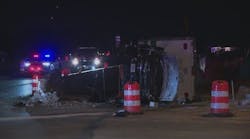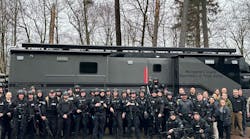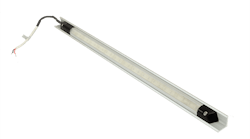Anyone that has ever had the privilege of driving and operating fire apparatus can not deny the thrill and excitement associated with a "Code 3" response. However, some questions come to mind in regards to this response.
What kind of training and/or experience did you have prior to your first Code 3 response? Did anyone in any of your driver training sessions inform you of your rights and obligations under your state vehicle and traffic laws, or any other laws or statutes in regards to the operation of emergency vehicles? In most cases, probably not.
Now I will relate to you my own personal experience, which is probably not unlike your own. I joined a volunteer fire company in 1974 that went on about 100 runs per year. I had always had a keen interest in trucks, so it was natural for me to learn how to drive and operate fire apparatus. I started my driver training in 1975. The first apparatus I had to conquer was a 1948 750gpm Mack pumper that required 17 steps to get water.
My training encompassed the next two years in which I learned how to drive and operate two pumpers, a tanker and a rescue van. I went to a state-sponsored pump operators' school. My training was excellent and I felt fairly comfortable in my new role as an apparatus driver. But there was a problem with my training, a problem that I would not recognize for the next 17 years.
In 1981, I started working in a career department. I received limited experience driving and operating ladder trucks. In 1987, I build a new home and joined the volunteer fire department in the next town over. In this department I was trained on our two pumpers, one tanker and one brush truck.
Again the same training took place: driving, pumping and operating the apparatus. This department's driver training was superior in every way, in fact this was the best training program I had ever had. Yet, there was still something missing.
In 1989, my career department sent me for two weeks of driver training. This school taught us how to drive and operate aerial ladders, tillers and tower ladders. The training was good, but again something was missing.
In 1991 I took my first Emergency Vehicle Operation Course (EVOC). After 17 years, I identified the missing piece to the puzzle. I had never been taught the rules of emergency vehicle driving. I did not know that there was a special section of the state vehicle and traffic law devoted strictly to the operation of emergency vehicles. If you were a football coach would you send your team out on the field without knowing the rules of the game? Certainly not. Yet we in the fire service have done this for many years.
We have taken people and put them behind the wheel of fire apparatus without knowledge of their rights and obligations under the law. This is still going on. How do I know? When I teach my EVOC class, I have students with 30, 35 even 40 years of experience as emergency vehicle operators and, when I cover the vehicle and traffic law, some sit there with a look of disbelief and others mutter, "I didn't know that."
In 1991 I found that I had been taught how to operate fire pumps and aerial ladders. I had been taught how to drive pumpers, ladders, tankers, brush trucks and rescue vans. But I had never been taught how to operate an emergency vehicle. What's the difference?
When you drive a fire truck down the road with no lights or sirens, you are just another truck on the road. A fire truck under these conditions is no different than a dump truck, garbage truck or any other truck. The minute you reach over, turn on the warning lights and activate the siren, you have changed from a fire truck to an emergency vehicle.
When I first operated emergency vehicles in 1975, the unspoken rule about Code 3 response (lights and sirens) was to get to the scene as quickly and safely as possible. Heavy emphasis was placed on speed. Basically, as long as you were behind the wheel of a fire apparatus on a Code 3 response, you ruled the road, put the pedal to the metal and tried not to get into an accident.
But, accidents do happen and if you are unfortunate enough to get into an accident, don't worry, you're a firefighter, helping people, a public servant and all around nice guy. Nothing will happen to you. That attitude may or may not have been true in 1975, however today it is completely untrue. With lawsuits being filed at record rates and liability awards being given out in record amounts, we now know that the fire service can be held liable for its actions.
Look at what the U.S. Fire Administration EVOC manual says about that sort of cavalier attitude. The consequences of thinking you are guarded, by being in the fire service, against recrimination or lawsuit, can and has led to a false sense of security.
These mistakes can and have been costly to: 1) Fire chiefs 2) Fire companies/departments 3) Municipalities or jurisdictions (fire districts), to say nothing of the individual firefighters named in lawsuits.
The previous statement infers that a lawsuit brought against a fire apparatus driver for example, may have a ripple effect and draw in not only the driver, but all people with authority above him within the structure of the fire department.
Simply stated, if you are the driver in an apparatus accident and are named in the lawsuit, you could possibly take the officer riding with you (if applicable), the fire chief, fire district officials, maybe a city manager and any other fire department or governmental officials connected with the fire department into court with you.
The U.S. Fire Administration EVOC manual also says: "The backlash against future occurrences by the organization and/or municipality will place the participants under a microscope."
This could make future relationships tense or outright unbearable. How do you think the public will react to an apparatus accident involving someone from the general public? Probably not too well.
In some instances, due to the conditions of the suit and findings of the case, fire stations have been shut down, charters dissolved and fire protection contracted from neighboring municipalities. The judgment from a case may force a fire company into bankruptcy.
It is time for you to investigate and educate yourself on all the laws, whether they be state, local or any other laws that pertain to the operation of emergency vehicles in your jurisdiction. Know what to expect if you get into an accident, know your rights so that you can act accordingly after you have had the accident and, most of all, be prepared. Ignorance of the law is no excuse and could ruin you both personally and/or professionally.
Remember, the only thing that nearly 50,000 emergency vehicle operators, that wrecked last year, have in common with you is that they didn't think an accident will happen to them either.
Lt. Mike Wilbur is a 21 year veteran of the FDNY assigned to Ladder Company 27 in the Bronx. Lt. Wilbur also serves on the FDNY apparatus purchasing committee, and has given state certification to the FDNY chauffeurs school. Visit his website www.emergencyvehicleresponse.com to learn more about Emergency Vehicle Driver Training that can be offered at your fire station.




